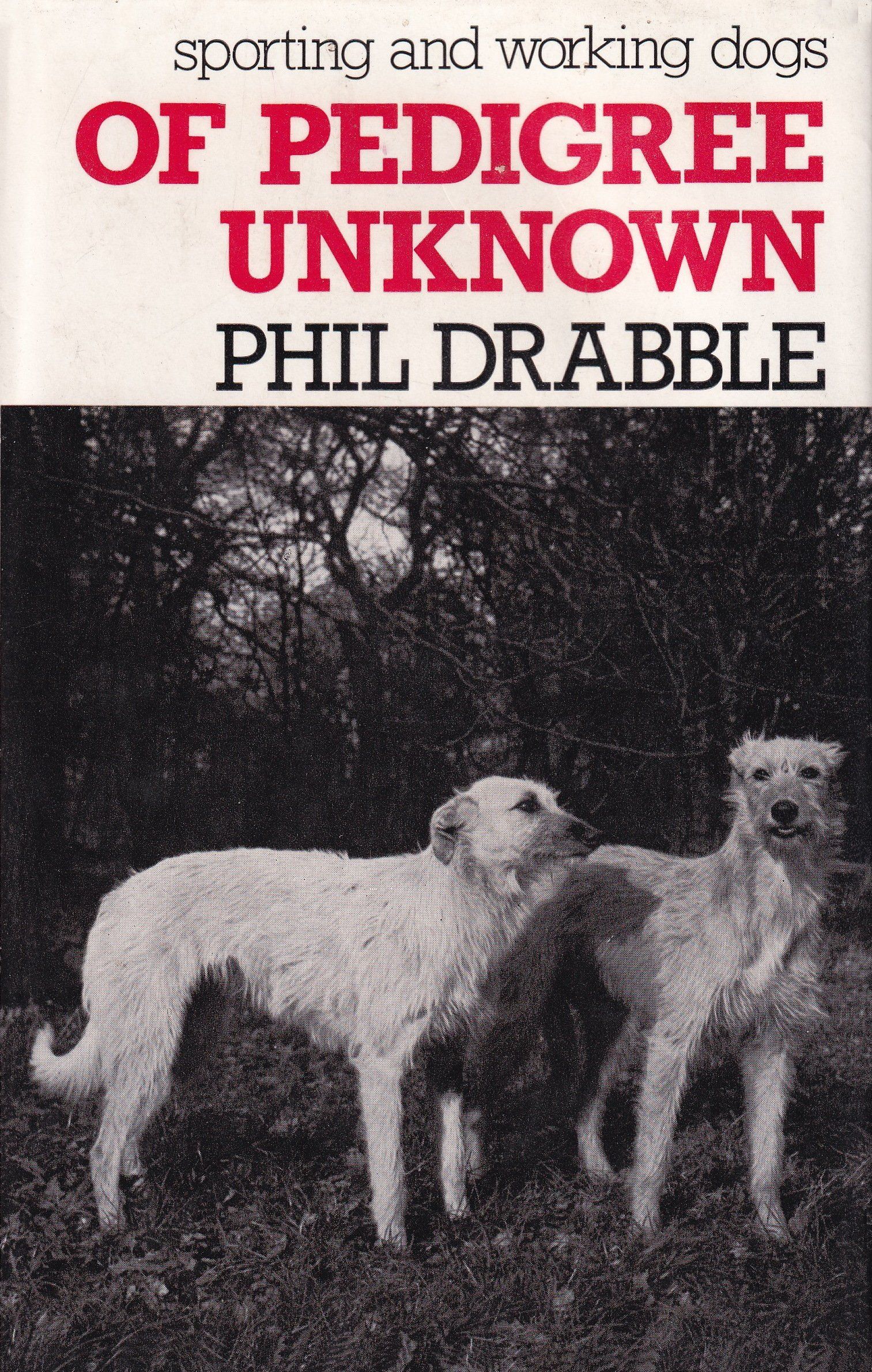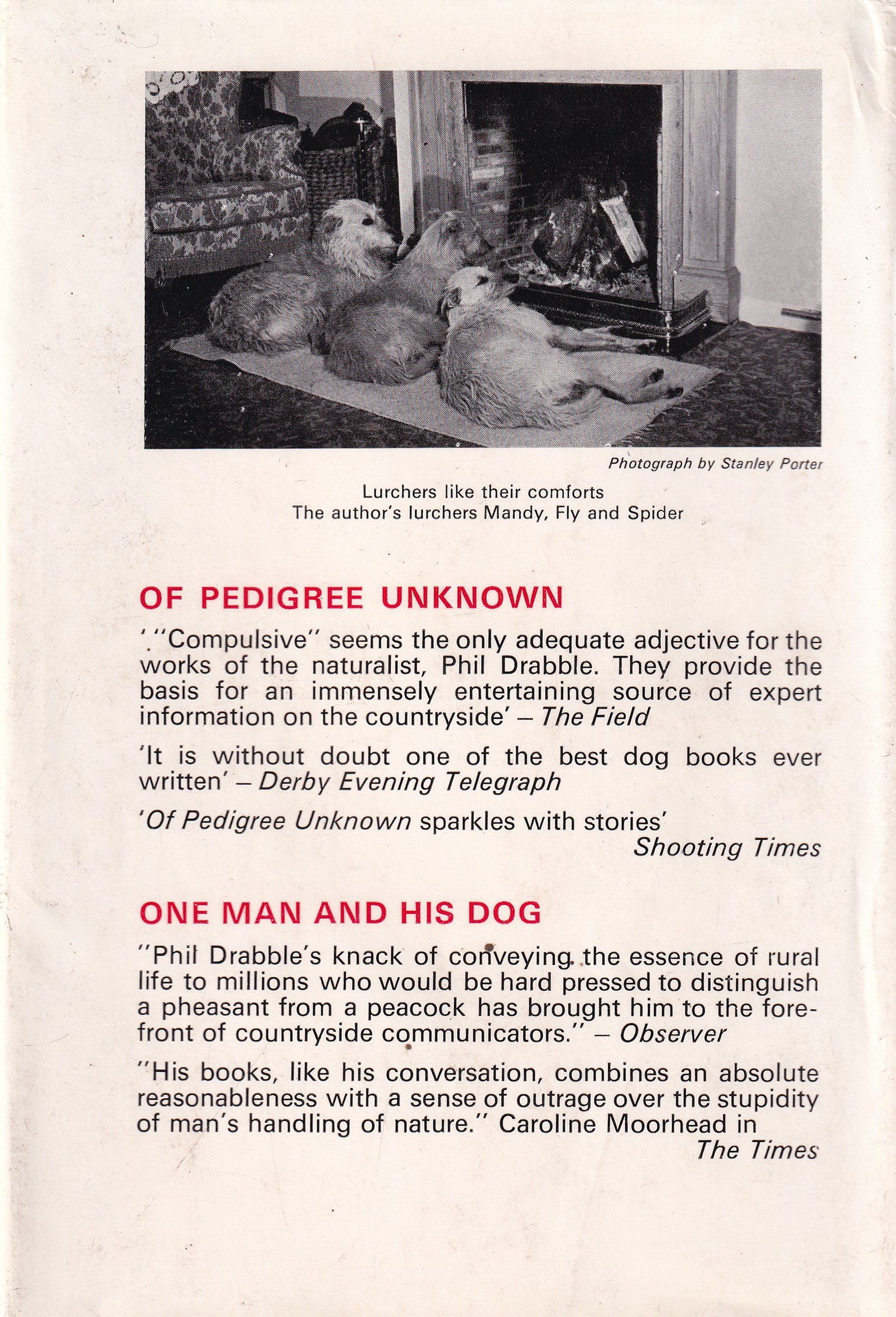First Published: 1964
1st published in Great Britain by:- Cassell & Co, 1964
2nd edition published by Michael Joseph Ltd, 1976
Second Impression June 1976
Third Impression November 1976
Fourth Impression January 1979
ISBN: 0 7181 1447 7
Hardcover 153 pages with dustjacket
size 20.5cm x 13.6cm x 2.8cm approx
weight 330g approx
Book Description:
Phil Drabble has never been without a dog in his life. He believes that you can judge both men and dogs by the company they keep so that he prefers working dogs to pampered pets.
The author is a naturalist who can still appreciate the skills of sporting dogs and sporting men. This common bond threw him into contact with poachers and gamekeepers who taught him more natural history than all the boffins with butterfly nets in biology labs at school.
Mick, his first terrier, introduced him to Hairy Kelly, a professional rat catcher who filled his purse and purse nets with equal guile. Dinah, his whippet lurcher, came from Bert Gripton, terrier man to the local hunt, who taught him the countryman's arts of watching and waiting.
Such rural individualists roam hedgerow and field -a law unto themselves and they initiated the author into the arts and sciences of rabbiting and ratting, ferreting and whippet running and early morning poaching. Each success or failure increased his appetite for such sports and taught him to coax and train his dogs to develop their specialist skills.
The extinct fighting dogs of Staffordshire chain-makers, tiny terriers in the rat pits of Black Country pubs or delicate whippets which earned their masters more than their wages. may not have had impressive pedigrees but they had guts and intelligence it would be hard to match.
CONTENTS:
LIST OF ILLUSTRATIONS
PREFACE
1. FIRST LOVE
2. MIXED COMPANY
3. THE BODYGUARD
4. FIGHTING DOGS
5. RAT PITS AND RUNNING DOGS
6. THE TERRIER MAN
7. LONG DOGS
ILLUSTRATIONS
1 The author's Dinah. A whippet-lurcher, produced by crossing pure whippet dog with whippet/ terrier bitch.
2 An old-fashioned start-now illegal-where the slipper throws the dog to land in his stride at full speed.
3 A modern start, where the dog is simply released and pushes himself off with both hind feet.
4 The race. A bad start. The pistol has fired, but no dog is yet on the move.
5 A good start. The pistol has cracked and three out of four dogs are already on their way.
6 Bert Gripton, the terrier man, with a bunch of the right sort of working terriers.
7 The end of the dig. The terrier keeps just out of reach and 'bays' or 'speaks' to the fox, to keep him where he is and to let his master know where he and his quarry are.
8 Bert Gripton handles the fox, which is alive and unharmed.
9 The author's Gipsy. A lurcher, produced by crossing half-bred deerhound and thoroughbred coursing greyhound.
10 The author's lurcher bitches Amber and Gypsy in action close on their hare.
All photographs are by Derek Johnson
Cover Photo: Spider and Fly, the author's lurchers
PREFACE
My dogs earn their place on the hearth by deeds not looks. If they are faithful, hardy and intelligent, I don't care a jot if their pedigrees are wrapped in mystery.
For more than twenty years my hobby was ratting and I believe that rats are the slickest, most cunning quarry that lever pitted my wits against. Men who could think and act as quickly in tight corners would soon be tycoons.
I am glad that the 1973 Badgers Act has made badger digging illegal because I am particularly fond of badgers and digging them
with terriers was often exceptionally cruel to both dog and quarry. Competitive hare coursing is out of favour though the act appears to have been drafted largely to prevent competitive coursing meetings and there will still be nothing to stop a loose dog giving chase to a hare which "happens" to get up in front of him. Long dogs and their owners may still be able to catch their dinner without penalty - unless they are poaching.
Whippet racing is now more popular than at any time since the Great War and no sport is more spectacular. Rabbits are holding their own with myxomatosis and the most scientific Pest Destruction Officer does no better than old-fashioned rat catchers, so that there is as yet no prospect that quarry will run out for sporting dogs.
P.D. September 1975
Extract:-
“Fighting Dogs
By the time I left school at seventeen, I had two burning ambitions. One was to own a bull terrier and the other was to own a whippet.
To us, in Staffordshire, there was only one kind of bull terrier-the 'Stafford'. At that time it was not recognized as a breed by the Kennel Club, who only acknowledged 'English' Bull Terriers, the white, pig-faced, rather clumsy creatures evolved by Hinks in Birmingham nearly a century before. Many of them were deaf, in common with some other white dogs, and there was a movement afoot to breed 'coloured' English Bull Terriers, including some with the brindle and fawn markings of Staffords. But the fact remains, English Bull Terriers were show dogs, and ours, Staffords, were bred for work-the very specialized, brutal work of fighting each other in the dog pits.
Whippets were not recognized by the Kennel Club either. Or not the sort of whippet I wanted. My father had an industrial practice, and a great many of his patients were coal miners and ironworkers who still kept fighting cocks and bull terriers to fight, and whippets and pigeons to race. I grew up to know a lot of the men well, and loved nothing better than to spend Sunday morning on a tour of their back yards, admiring their dogs and their birds and hearing their stories of great races and battles-which often ended in a battle of owners as well.
For this reason it was not considered 'respectable' to keep 'a cock' or 'a dog', which were very specific terms in my youth. Any fowl that was not pure game, bred from stock which had been 'tried in the pit', was a 'muck hill', and any dog, however highly prized by the people who haunt dog shows, was 'a cur' if it was neither whippet nor pit dog. Coming from a 'respectable' household, I was told that I could not have a bull terrier until I was earning money to pay for the damage it did; and there would be no 'poacher's' dogs in the household either.
The first week's wages I ever earned, in an engineering works at _ Bilston, was forty-five shillings. I spent thirty shillings of it on Grip, my first bull terrier. At five weeks old he was pot-bellied with worms, and anything but promising. The bitch which bred him belonged to a chap in the factory toolroom, and the dog which begot him was said to have won some redoubtable battles. There was no pedigree and no proof. Fame of such dogs was spread by word of mouth and they had no highfalutin' Kennel names, like show dogs have. They were Arblaster' s Mick or Timmington's Floss-and everyone knew that chaps like them didn't keep rubbish, or stuff that wasn't game.
Dog fighting had been illegal since 1837. It had not stopped, but penalties grew progressively tougher for those who were caught, until it finally died in the 1940s.
It was not as easy to get convictions for dog fighting as it was for cock fighting. There has always been a certain glamour about game fowl, and devotees of the sport come from every walk of life, from belted earls to Black Country colliers. Indeed, there have been two fairly recent prosecutions, on a large scale, for cock fighting, one just before the war and one in the 1950s."In both cases the cockers 'asked for it', because they grew so bold as to become foolhardy.
Indeed they sent their birds to one 'main' by rail. A gamecock has a most characteristic crow, and it is not surprising that eyebrows were raised at the number of baskets emitting martial music which arrived at one little Cheshire station. Authority-or a team of authorities-hid overnight, waited until battle had commenced with a vengeance, and collared the lot. The occupations of the captives ranged from miner to vet, from spinster to factory owner.
The dog men were far more cagey. It was a sport of working men, and on the whole pretty rough working men at that. The number of men at a fight was rarely more than four or five, they never fought at the same place twice-and they chose some pretty unlikely places too. I know of fights in a railway truck, a bedroom 'cellar', hollows in disused pit banks and even a chapel on Saturday night-and it would be difficult to conceive a more unlikely place than that: Finally, if trouble with the police did blow up, no body of men can stick closer and say less than a bunch of tough Black Country chainmakers and colliers.
The history of dogs bred specifically to fight goes back to the bull-baiting days of last century. At one time bull-baiting had been a lawful, even compulsory, pastime with a strictly utilitarian objective. Men have long believed-and I think correctly-that meat from an animal which has died after recent exertion is more tender than it would otherwise be. A hare that has been coursed is always deemed superior to flesh from a shot hare. The whole carcass is flushed and cleansed, the theory has it, by blood purged clean by effort. So a bull that has died defending himself from a succession of bulldogs, each bent on 'pinning' him with a vice-like grip of his tender cheek or nose, was thought to be less tough than he would have been without the enforced exercise. In medieval times it was illegal to kill a bull that had not been baited, and the owner of the bull was obliged to advertise the fact so that the locals could attend the last grim rites. This had the advantage that, since everyone knew when a bull was……”
About the Author
https://en.wikipedia.org/wiki/Phil_Drabble
Also available
Paperback
Publisher : Harper Collins Distribution Services; New edition (1 April 1978)
ISBN-13 : 978-0006348252
Hardcover with Dustjacket
Publisher : Huddlesford Publications, 1988
ISBN 10: 0907827055ISBN 13: 9780907827054


